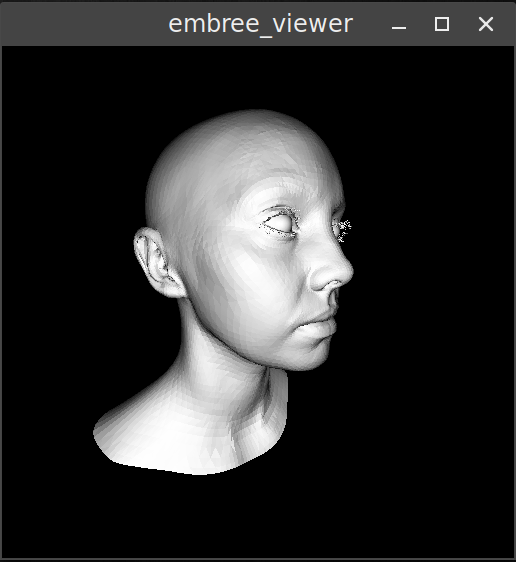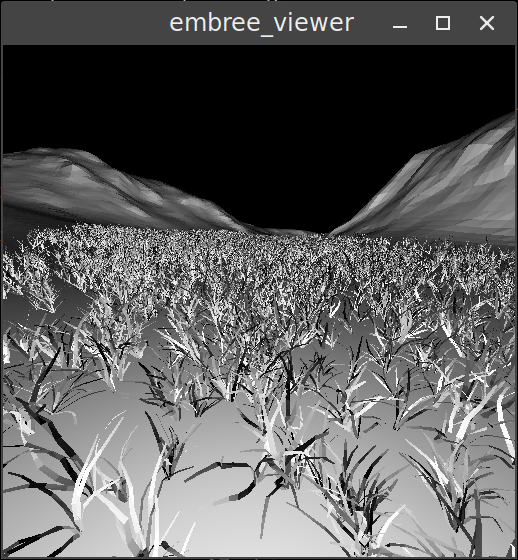Embree viewer is a simple implementation of a progressive renderer, based on Intel's Embree raytracing kernels. Its UI is written in SDL2, and it supports Alembic and OBJ model file formats, with a simple JSON file to describe a scene.
Embree viewer is intended as a simple example implementation of a progressive renderer with Embree, one step above the simple examples Embree ships with, but significantly simpler than Ospray and similar.
Its main purpose is to demonstrate the performance of Embree raytracing kernels, and the scalability of its instancing system, in a simple real-time multithread framework that can load common model files. It is not intended as a full raytracer - it does not have any support for materials, textures, normals, lighting or sampling.
Isotropix Clarisse is a professional lighting tool, heavily focusing on efficient object instancing. It is available as a professional package, or as a Personal Learning Edition.
For the purposes of experimentation with Embree, the clarisse directory contains a number of PLE scene files, with a set of scripts to export their scattering setup to a set of JSON and binary files compatible with Embree viewer.
Embree viewer was developed on a standard installation of Debian Linux; it has not been tested on MS Windows (any contribution in that respect would be appreciated).
Non-standard dependencies, which have to be compiled on the target Linux machine, and installed into a location available to CMake:
Standard dependencies, available in Debian (or other Linux distro):
- Boost (tested against 1.62.0)
- OpenEXR and IlmBase (tested against 2.2.0)
- SDL2 (tested against 2.0.5)
- TBB (tested against 4.3)
The repository contains a standard set of CMake build files:
mkdir build
cmake ..
make -j
Allowed options:
--help produce help message
--mesh arg load mesh file (.abc, .obj)
--scene arg load a scene file (.json)
The viewer implements only minimal mouse interaction (for now):
- left mouse button + movement rotates around the current origin point
- right mouse button + movement moves the camera towards or away form the origin point (using logarithmic scale based on distance)
- left double click selects the camera's focus point to the point of intersection between the camera ray determined from the click and the scene
At the moment, there are 3 input file types - .abc, .obj and .json.
Scene file is a very simple JSON-based file format, describing the input files and scattering information.
The root of the scene is a json list, enumerating the elements of the scene. Each element can either be a subscene or an object.
Each object is represented as a simple dictionary, with a filesystem path (absolute or relative) to an .obj or a .abc mesh file, and a 4x4 matrix transform represented as an array.
A scene is a dictionary containing an array of objects (each either an object, or another sub-scene), a transform acting as a parent for all objects and either a set of instances in an array of structs with id and transform, or an instance_file link to a binary file containing the instancing information. A scene_path string then represents a unique ID of the instanced sub-scene in the scene file, serving as an identifier to de-duplicated sub-scenes.
The instancing file is a plain binary file, containing 17x32bit data records:
- first 4 bytes represent a 32-bit unsigned integer, referencing which of the
objectsrecords should be used for this particular instance - 16 4-byte records after that represent a
transformation matrixof each instance (composed of 32-bit floats)
Embree viewer comes with a small number of example files in the data directory (each directory includes a LICENSE file for the files it contains):
Virtual Emily project's main mesh, demonstrating how to load a single model file.
/embree_viewer --mesh data/Emily/Emily_2_1_Alembic_Scene.abc
A simple scattering scene, using assets exported from Blender and Clarisse, showing the performance and possible complexity of the scene.
/embree_viewer --scene data/Grass/scene.json
This demo is licensed under MIT license, and as such you can use this code for both commercial and noncommercial purposes.
Any contributions are welcome, in terms of ideas, improvements, bugfixes or additional example files.


